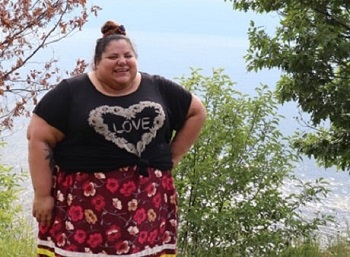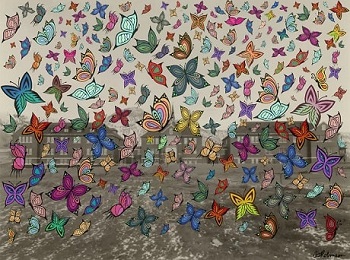Disclaimer: This blog contains discussion about residential schools which may be upsetting and/or triggering to some readers.
A collective mourning for Indigenous communities
When the news broke about the findings of the children’s’ remains in the Spring of 2021 Danielle Robinson, didn’t know how to feel. For the first few days, she avoided thinking or talking about the news.
 |
| Danielle Robinson wearing a ribbon skirt, a garment of clothing typically worn by Indigenous women. |
Danielle is an Anishinaabe woman who has worked with the Canadian Red Cross since August 2020 and who has honoured the organization with her insights and expertise gained through both life experience and her Master’s in Public Health.
For Danielle and many other Indigenous people, the recovery of the children’s remains at Tk'emlups Residential School affirmed what they knew for decades: countless children were taken from their families and communities to attend these schools, and never returned.
The devastating child abuse that occurred within the walls of hundreds of these schools would have lasting impacts on Indigenous peoples for generations. With multiple discoveries of unmarked graves across North America, people worldwide have started to take notice of our collective truth.
A brick building and 215 butterflies
Art has always been a part of Danielle’s identity. To process her emotions and express how she was feeling following the traumatic announcements, she turned to art. Throughout her childhood, Danielle recalls that whenever her mom would see a butterfly, she would affectionately point out that it was her grandma. |
|
“215 Free” courtesy of Anishinaabe artist Danielle Robinson |
In this way, Danielle had come to associate butterflies with spirits. She recalls that she was told that “spirits come back in other ways.” Over the next few days, she recalls that she began drawing butterflies, and before long, she had more than 40 unique butterflies.
Among the breaking news stories, one image continued to surface: a grey-scale, archival photo of an ominous brick building: the Tk'emlups Residential School. Danielle was inspired to superimpose her beautiful butterflies over the dreary image. Before long, she had laid 215 unique and colourful butterflies across the images – one to represent each suspected child detected by ground-penetrating radar.
“Butterflies undergo a transformation,” Danielle notes, “Regardless of its life before, the butterfly is able to go off and be that beautiful spirit, regardless of what had happened to it before then.”
For Danielle, once she was able to see through the immediate pain that rippled out from the announcement at Tk'emlups, she could find some peace in knowing that the children’s remains had been located after so many years.
“Now these little children’s bodies are being brought home to be given proper burials by their families and communities,” she says.
In the aftermath of the recovery, sacred fires were held across Canada, in keeping with Indigenous burial traditions. These fires are believed to aid the spirits to cross over. For Danielle, while painful, the recovery work done at Tk'emlups and other residential schools is an important step in setting families free and starting on their healing journey.
As communities process, the search continues
In the months that followed, Danielle spent a lot of time talking with friends and family as they came to terms with the news. She recounts, “My artwork helped other people process their emotions and understand what was happening.”Tk'emlúps te Secwépemc was the first Indigenous community in Canada to use ground-penetrating radar to identify the suspected remains of children at a former residential school site. Since then, several other Indigenous Communities have followed, using similar technologies to begin to uncover the truths buried at the site of former residential school buildings across North America. The search for answers and closure continues.
It has been a little over a year since the first announcement, with each following announcement continuing to bring up many emotions for Indigenous and non-Indigenous communities alike.
Feelings of shock have washed over many non-Indigenous people as the truth of Canada's colonial legacy has been revealed – something that has often been glossed over or even omitted from the public education curriculum. Those interested in learning more can register for “Indigenous Canada,” a free, online course offered by the University of Alberta. The course explores the different histories and contemporary perspectives of Indigenous peoples living in Canada, the history and impacts of colonization including a look into the Residential School system.
The Canadian Red Cross Society is honoured that that self-identifying Indigenous staff such as Danielle Robinson have chosen to contribute their expertise and experience to the humanitarian objectives of the Society. To join the many Indigenous staff such as Danielle at the Canadian Red Cross, consider applying to one of our exciting postings. We encourage all qualified persons to apply, particularly Indigenous peoples, persons with disabilities, racialized people, and people with diverse gender identities and sexual orientations, and others who share our values and contribute to fostering an inclusive and diverse workplace.
Please view the Indigenous Peoples Framework to learn more about how the Canadian Red Cross seeks to foster meaningful relationships with Indigenous communities.
Related stories:

